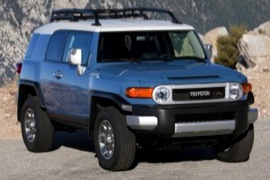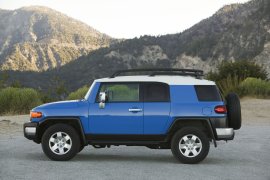TOYOTA FJ Cruiser Models/Series Timeline, Specifications & Photos
First production year: 2006
Engines: Gasoline
Body style: SUV (Sports Utility Vehicle)
The name FJ had an important meaning for any Toyota Land Cruiser enthusiast. And the FJ Cruiser was built to resemble that legendary model.
Launched in 2011, the FJ Cruiser resembled the 1970s – 1980s Toyota Land Cruiser FJ. A car that was boxy, rugged, and with a go-everywhere capability that made the 2011 SUVs slide out from the scenery. But it wasn't just the look.
The FJ Cruiser took the old model's front design and updated in a new interpretation. It was like a black & white old movie but remastered and colorized. And the designers did their job well. The round headlights, the straight, horizontal grille, and the angular wheel-arches resembled the old FJ40. Like the old model, the FJ Cruiser featured a vertical windshield with three wipers and rounded corners in the back of the greenhouse. The car featured rear-hinged rear doors, which could have been opened only if the front doors were opened first.
Inside, the retro-design was continued with a classic look for the dials and the big turning knobs for the ventilation system. Everything was designed to be used with a pair of working gloves on (apart from the steering-wheel buttons). The gear-selector and the transfer-box stick were mounted on the floor. Toyota didn't want to put a push-button for the transmission. Its fans were known to prefer the simple, mechanical levers.
Under the body, there was a ladder-braced frame chassis. The front independent suspension and the solid rear axle were part of the rugged, yet comfortable, package. The car was offered with different transmission ratios, to be used on rock-crawling. The rear locking differential was standard for the manual transmission and fitted as an option for the automatic.
Toyota introduced the FJ Cruiser at the 2005 North American International Auto Show as a retro-styled SUV built on top of the Land Cruiser Prado platform.
The idea of a retro-styled SUV was born in the mid-'90s at Toyota's headquarters, and the project was strongly supported by no other than the company's president, Akio Toyoda. Even though the carmaker already had a few chassis available to create the car, the final solution was found on the Land Cruiser 120, which was the latest and most competent one to support such a project.
With a design that left no doubt about its FJ40 heritage, the FJ Cruiser sported a flat front fascia with two round headlights that flanked the grille. Moreover, the automaker didn't put its logo on it but used the complete name instead. In addition, the bumper resembled the aftermarket ones mostly used by off-road enthusiasts on their FJ40s, albeit it was not made from steel but from plastic. Still, it featured silver trims that mimicked a shield. From its profile, the squarish wheel arches and the flared wheel fenders made room for big, off-road tires. But the most unusual part of the vehicle was found on the doors. The front ones were regular, but the rear-hinged ones were unique. Moreover, when both were opened, there was no B-pillar, so passengers could easily climb inside.
The cabin showed a minimalist design, with flat plastic areas and a center console separating the front passengers. In the back, the bench was profiled for two, albeit it could host a third person. At the same time, the trunk could've been expanded by lowering the rear bench.
Under the skin, the FJ Cruiser sported a ladder-frame chassis fitted with an independent front suspension and a live axle in the back. Power came from a 4.0-liter V6 that drove all the wheels via a five-speed automatic or a six-speed manual.

